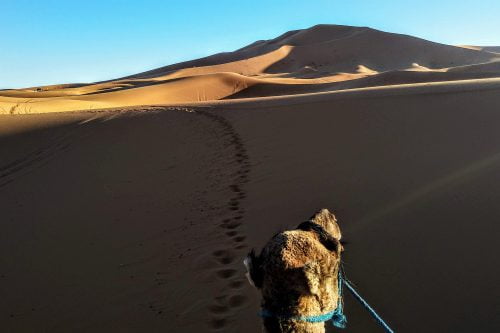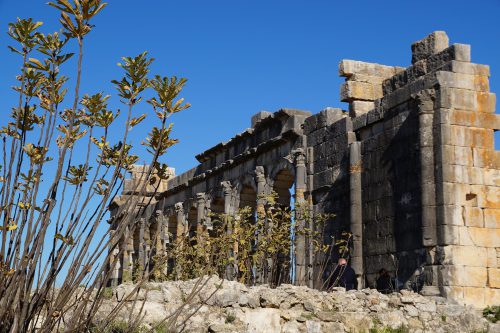Description
“Before Marrakech, everything was black. This city taught me colour, and I embraced its light, its insolent mixes, and ardent inventions.”
Yves Saint Laurent
Yves Saint Laurent perfectly described Marrakech, one of the four imperial cities of Morocco. It’s impossible not to be fascinated by the blue of its sky, the pink of its city wall, the thousands of colors of its souks brimming with beautiful and unique handicrafts. Visiting its palaces, enjoying its museums, letting ourselves be overwhelmed by the daily evolution of Jemaa El Fna square (inserted in the UNESCO Lists of Intangible Cultural Heritage), getting lost in the medina’s narrow streets (UNESCO World Heritage Site)…it’s all something to do at least once in a lifetime.
Set aside the explosions of sounds and colors of this wonderful city, you can enjoy the peace and tranquility of the desert: Zagora and Merzouga await you.
We’ll spend the first days of our trip discovering the southwest of Morocco.
From Marrakech, we’ll head towards the Atlantic ocean; along the way, shortly before reaching Essaouira, we’ll start noticing many trees similar to olive trees but “wilder” looking, those are the argan trees (trees that we’ll find again on the trip-leg from Essaouira to Taroudant). The argan is a plant that grows wild in the Sous valley in Morocco and in part of Algeria. From its fruits, a precious oil is obtained (Slow Food Ark of Taste), an oil with cosmetic, therapeutic and nutritional properties. The entire oil production process, from the harvest of the fruits to the bottling is almost exclusively carried out by local women, generally reunited in cooperatives.
Essaouira, located on the Atlantic coast, has been since forever an important port connecting Morocco with the rest of Africa and Europe. With a delicious blue and white medina (UNESCO World Heritage Site since 2001), the port with its iconic blue boats and the fish market, the town is basically a must-see when traveling to Morocco.
Its story was a sequence of splendor and richness, but also of desolation and decline. It was the favorite destination of the 70s hippie generation, for a few years now it has been hosting the Gnawa World Music Festival, an event originally dedicated to music born out of the slaves from Sub-Saharan Africa – in particular from Sudan, Mali and Guinea – and now widened to contemporary funk, blues, jazz and soul music, that for 3 days transforms Essaouira into a beating center of music, art and culture.
Once left behind the coastline, and driving down a road flanked by the High Atlas and Anti-Atlas mountain range, our journey will head to Taroudant, known as Little Marrakech for its massive and ancient city wall that recalls those of the Pink City (namely Marrakech). Inside the medina there are two beautiful souks, respectively Arabic and Berber, with local products and handicrafts.
From Taroudant we’ll go to Tafroute, perched on huge granitic mountains of a spectacular pink shade; some said that it looks like you’ve just reached Bedrock, the town of the “The Flinstones”!
For those who love a bit of shopping, Tafroute is the land of babouches (slippers), but also of sugared peanuts.
The surroundings, a succession of charming landscapes, small villages of mud and straw huts and old Kasbahs alternate with beautiful oasis rich of water and palm trees.
The trip continues on to Zagora but before we reach the “desert’s gate” we have two options: heading east to visit the areas of Akka and Tata (two oases with mud building and beautiful Kasbahs) or heading north towards Taliouine. During the fall we suggest the second option because this small town, located on the Souktana plateau, is the Moroccan motherland of saffron (Slow Food Ark of Taste); therefore this itinerary gives us the chance to see the fields with the very much colorful flowers from which this precious spice is extracted. The blossoming reaches its peak between mid-October and mid-November, a timeframe in which the local women manually harvest the flowers, always before the sun rises when the flowers are still closed off to avoid the sun-alteration of their pistils’ precious properties.
In the first week of November a festival of the same name is dedicated to saffron.
Going south we’ll stop nearby Agdz to visit the ksar of Tamnougalt, considered by many one of the most beautiful in Morocco. It is a proper fortress with a defensive function located in a strategic point along the caravan route from Marrakech to Timbuktu.
Tamnougalt is where Bernardo Bertolucci filmed most of the interior scenes of his film “The Sheltering Sky.”
Spending a night in Zagora will allow us to visit Tamgroute, a village made of a group Kasbahs (some are underground), famous for the production of a particular type of green pottery and for the ancient Koranic library which treasures a collection of precious volumes. In Tamgroute, it’s held one of the most famous “Moussem” (festival) in southern Morocco;
From Zagora, we’ll head towards Merzouga. Along the way it’s a must to stop by Alnif at the end of a lunar-like valley of red earth and rocks to buy some caraway that here it’s famous for having a particularly intense smell (Slow Food Ark of Taste).
Once we reach the edge of the desert, we’ll leave the car to reach by dromedary riding the campsite where you’ll spend the night, after relishing the sunset on the desert.
The following day will be dedicated to the exploration of the desert, its world and its inhabitants. You’ll be welcomed by a nomadic family and you’ll savor the Berber cuisine and enjoy life in the desert.
Once we leave the desert behind, we’ll start our trip back, visiting Rissani (with one of the most fascinating markets of the Country) and crossing the Dadès and Todgha Gorges.
After a night in Boumalne Dades, we’ll begin the last day of our tour; while driving through the Roses Valley we could stop in Kelaat Mgouna to buy rose water (it’s must-stop if you’ll be traveling between the end of May and beginning of June when the Rose Festival takes place) or to meet the nomad families who live in the caves; or we might decide to stop and visit the Kasbah of Amridil in Skoura, or stop in Ouarzazate and spend a few hours visiting the film studios and Taourirt kasbah or even head straight to the mountains and visit the ksar of Ait ben Haddou (UNESCO World Heritage Site since 1987) and, just before making it over the pass and starting our way down towards Marrakech and visit the Kasbah of Telouet perched in the Atlas mountains range.
Or maybe you can just add a day to your trip and visit everything!
The Tour Includes
The Tour Does Not Include
Write and tell us what you have in mind, we will suggest the perfect itinerary for you based on the dates of your trip!

